The Buccaneer Archipelago is a stunningly rugged area off the Kimberley coast in Western Australia, consisting of up to 1000 islands. The scenery is perhaps the most spectacular of any island group in Australia, with secluded white sandy beaches, patches of rain forest, mangrove estuaries, plunging cliffs, indigenous rock art and hidden reefs that litter offshore waters.
The islands of the archipelago are mostly small with the largest being Koolan Island (27.1 km2), Hidden Island (19.7 km2), Irvine Island, Long Island (14.8 km2), Sunday Island (13.3 km2) and Lachlan (12.9 km2).
Situated approximately 2800 kilometres north of the Western Australian capital of Perth, the archipelago's distant location has meant it has remained an unspoilt and remarkably pristine location to explore and experience. The archipelago's name commemorates the first sighting of the islands by British navigator William Dampier and his companions in 1688.
The warm weather, water and remoteness of the archipelago have created an incredible breeding ground for a huge array of wildlife including crocodiles, snakes, birds, bats and most importantly fish. Visitors to the Buccaneer Archipelago find the fishing here exceptional and many species habitat the region in abundance. Your catch could include Barramundi, Coral Trout, Red Emperor, Trevally, Snapper Tuna and Spanish Mackerel, as well as oysters and enormous mud crabs.
Aboriginal people have lived in the Archipelago for thousands of years and their rock art can be found on many islands and the adjacent mainland. Using rafts of mangrove logs and canoes, tribes travelled between the islands. Indigenous groups today still visit their traditional sites and communities are established in the area.
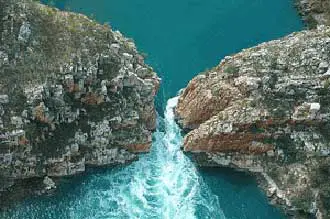
Horizontal Waterfall
Tides here are up to 11 metres and are among some of the biggest in the world, and certainly the largest in Australia. In some places they are treacherously strong and unpredictable, surging up rivers and ripping through inland passages. These tides create such phenomena as the Horizontal Waterfall in Talbot Bay. Here the tide rushes through the gaps in the cliff which are only a few metres wide forming the effect of a horizontal waterfall. At the peak of the tidal inflow or outflow the difference in levels is some four metres, which creates an astounding picture.

Montgomery Reef
Another incredible sight resulting from the high tides of the region is Montgomery Reef. Arriving by charter boat or by tourist cruiser to the area at high water, you drop anchor in what appears to be an endless ocean. As the tide falls right before your eyes, along a navigable channel running deep into the eastern reef, a stunning horizon of white water rapids is created. Suddenly, a loud, raging torrent of water erupts around you as Montgomery Reef appears to rise out of the ocean.
You find yourself in a narrow channel sinking slowly below the horizon. Contained by reef walls on both sides all you can see is the 'rooster tail' effect as the water cascades off the reef to the river forming below. What started out as a nice spot for a cuppa becomes a raging river as the waters rush past your vessel to battle its way out into open water.
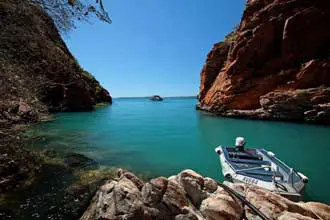
Cascade Bay
To the north is Cascade Bay which has a couple of springs and a waterfall cascading down onto a beach. Hells Gate is the entrance to Cascade Bay and aptly named. The tide rushes through the islands and creates many whirlpools, overfalls, rips and is an awesome sight. Cone Bay is home to a pearl farm and an Aboriginal Community and has many springs, waterfalls and pockets of tropical rainforest.
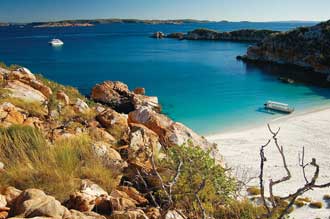
Strickland Bay
Strickland Bay is huge and holds many surprises. There is a pearl farm, rivers, mangroves, reefs, beaches, islands, great fishing and has the massive "Graveyards" estuary on the northern side. You could spend a week in Strickland Bay alone without running out of things to do. Whirlpool Pass is the channel between Hidden Island and the mainland, the name says it all. Hidden Island has a beach that is as white and soft as flour; visitors here often spend a whole day just lazing around in the turquoise water.
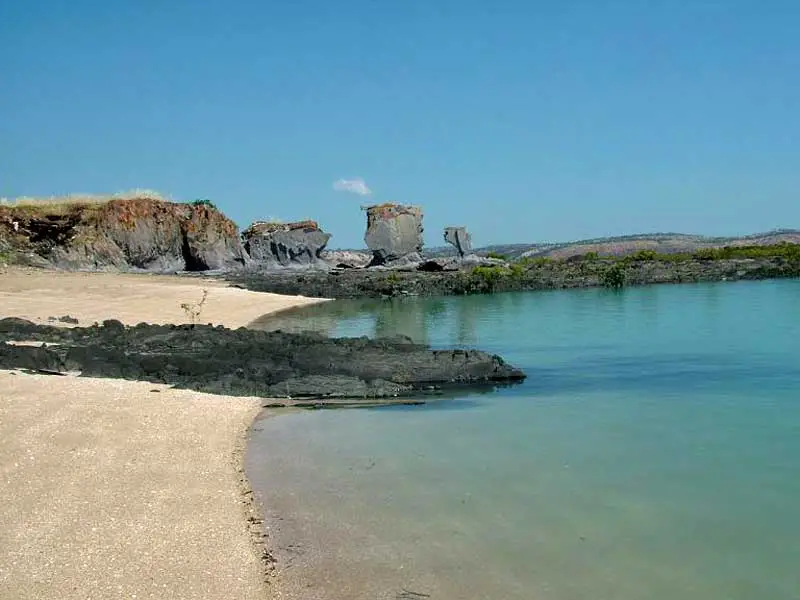
Edeline Island
Edeline Island is famed for its siltstone rock formations that resemble sculptures. The islands are known locally as "The Graveyards", as they contain 19th century graves of pearl divers; three unmarked, one with an inscription (dated 1891). Cone Bay, with tides of up to 11 metres twice a day, is fantastic for growing fish; its 'water circles' are in fact polar sea-cages used to breed Saltwater Barramundi.
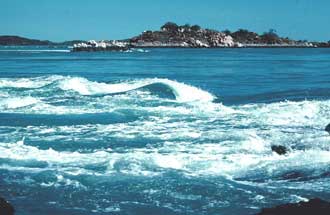
Hells Gate
This narrow gap separates us from Cone Bay and makes for a helluva ride on spring tides. The force of the tide either coming into the King Sound or receding back to the sea makes for some turbulent water with impressive whirlpools and back eddies to get the heart pumping.
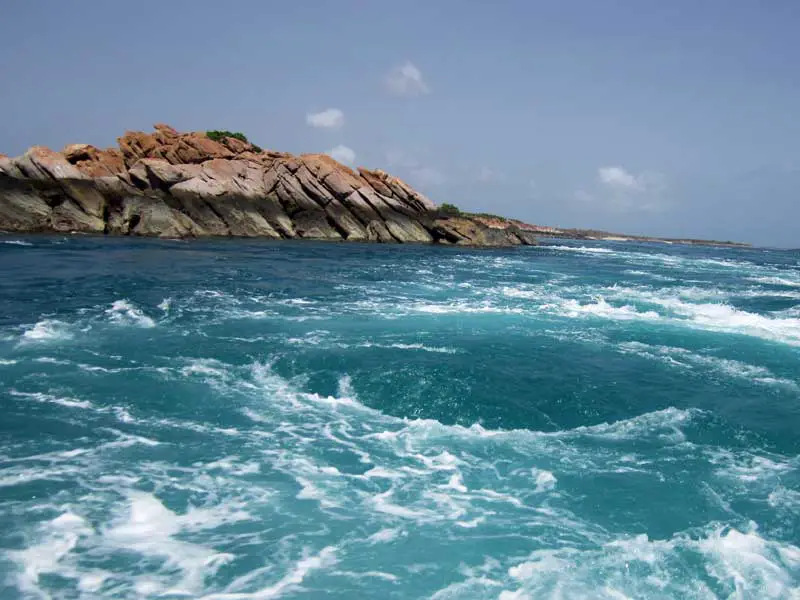
Whirlpool Passage
Whirlpool Passage divides Chambers and Hidden Islands in the Buccaneer Archipelago. A scenic 3 mile 'S' bend tour is characterized at times of peak tidal movement by large metre deep whirlpools and tidal flows in excess of 10 knots. Passing through the passage when the tide is running is a dramatic experience as your vessel negotiates the violent whirlpools. However, get there at the turn of the tide and it looks like a millpond and ever so peaceful.
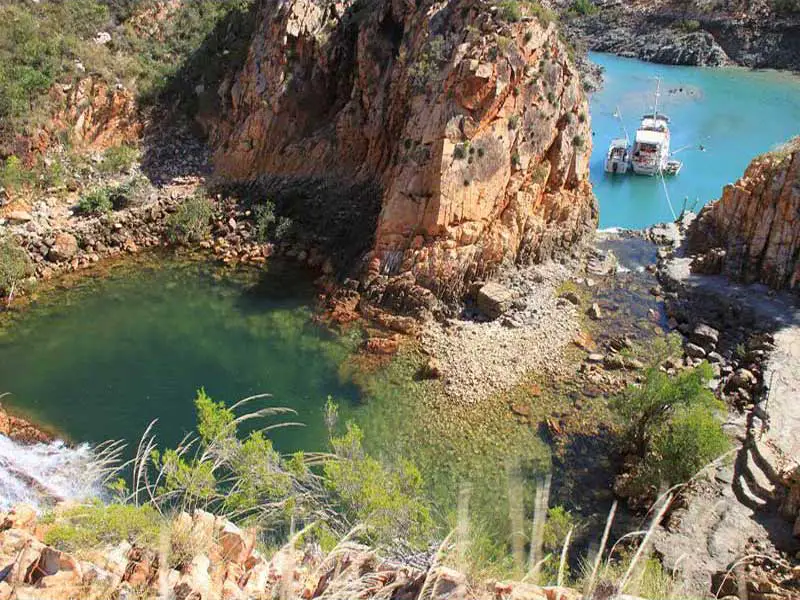
Crocodile Creek
Crocodile Creek in Yampi Sound is a little paradise tucked away behind the sandstone walls. The miners from nearby Koolan Island iron ore mine used this spot as a getaway site. With the top pool cascading into the lower pool and then onto the creek below, it's a delightful swimming hole with all the yachtie memorabilia left behind from passing travellers hanging from the shaded patio area. This spot makes for an enjoyable outing.

Hidden Island & Silica Beach
With its powder soft pure white sand and turquoise waters of the Indian Ocean, Silica Beach is a resort destination in the making. Enjoy a refreshing swim at this pristine beach or take the time to climb up the sandstone rocks for some great photography.
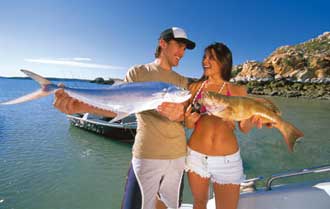
Walcott Inlet
Walcott Inlet is further east again and is a massive estuary that is home to three large rivers which are the Calder, Charnley and Isdell Rivers. The Charnley Rockbar is one of the most famous spots to land a Barracuda.

Raft Point
To the north is Doubtful Bay and the fabulous Raft Point rock art site. The huge bluff that is Raft Point is an example of the ancient, much-weathered sedimentary layering of the King Leopold Sandstone underlain by a massive intrusion of Carson volcanic basalt, all of which is between 1.83 and 1.78 billion years old. A 150m climb up a steep hill reveals a cave that overlooks the mass of Steep Island. This site has many quality Wandjina figures amongst other depictions of marine and wildlife. It is also home to Vinneys Creek that has great fishing, Red Cone Falls, Glenelg River and the Sale River which can be navigated 15kms up the gorge to a freshwater sandy beach and spring.

Langgi
Travelling further north is Langgi which has the petrified stone warriors, then on to Deception Bay and Sampson Inlet which is a natural cyclone shelter with rainforest, freshwater springs and pools. Futher north is Kuri Bay and Brecknock Harbour, the Prince Regent River and the Kings Cascades, famous for the crocodile attack on American actor Ginger Meadows.
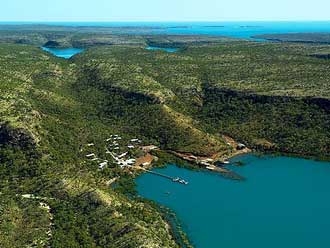
Kuri Bay
As pioneers of one of Australia's premier export industries, the Paspaley Pearling Company at Kuri Bay enjoys a long and colourful history which began with a Greek family fleeing war-torn Europe during World War I. The family has been involved in the pearling industry in Australia for over 70 years and today the Paspaley name is known around the world as the producer of the world's finest quality pearls. Kuri Bay itself was named after T. Kuribayashi, a Japanese pearl industry executive, in 1962.
The mother-of-pearl shell initially drove Western Australia's pearling industry which supplied up to 70 per cent of global demand for the shell, mostly for use as buttons. Following the boom years in the 1930's, the invention of the plastic button changed Australia's pearling industry forever, the pearling fleets were abandoned with many of the traditional luggers simply left to rot on beaches up and down the coast. Nicholas Paspaley, however, was determined to secure the future of his growing pearling business and inspired by the success that the Japanese had enjoyed with culturing pearls, he began producing South Sea pearls that could match, if not exceed the quality of the rare natural pearls.
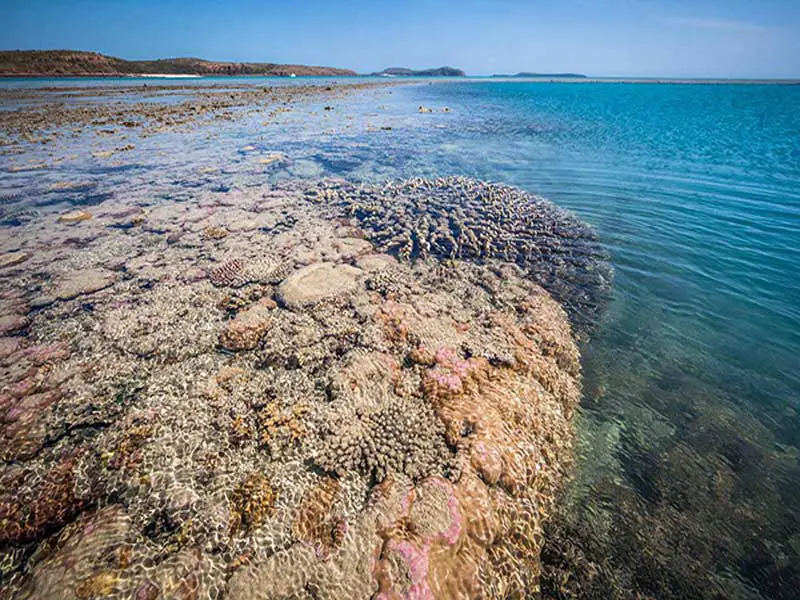
Augustus Island
Augustus Island, which stands as a divide between the islands of the Buccaneer and Bonaparte Archipelagos, is the largest island off the Kimberley coast; to its east is the site of the first, in this case ill-conceived, attempt at white settlement in the region. This was at Camden Harbour in 1864, and nine people died in the attempt.
Design by W3Layouts | Content © 2013 Phoenix Group Co. | Sales: phone 1300 753 517, email: [email protected]

